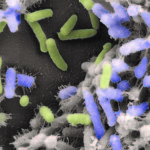Link to Pubmed [PMID] – 22273363
FEMS Microbiol. Rev. 2012 Sep;36(5):972-89
Multi-species biofilm communities are environments in which complex but ill understood exchanges between bacteria occur. Although monospecies cultures are still widely used in the laboratory, new approaches have been undertaken to study interspecies interactions within mixed communities. This review describes our current understanding of competitive relationships involving nonbiocidal biosurfactants, enzymes, and metabolites produced by bacteria and other microorganisms. These molecules target all steps of biofilm formation, ranging from inhibition of initial adhesion to matrix degradation, jamming of cell-cell communications, and induction of biofilm dispersion. This review presents available data on nonbiocidal molecules and provides a new perspective on competitive interactions within biofilms that could lead to antibiofilm strategies of potential biomedical interest.

